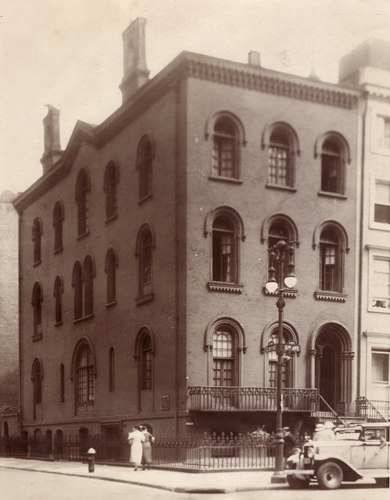
Mark Twain House
From November 1904 to June 1908, 21 Fifth Avenue was the home of Samuel Clemens – better known as Mark Twain. Demolished in 1954, the loss of this 1851 Romanesque Revival townhouse illustrated the challenges faced by preservation advocates before the protections of the 1965 New York City Landmarks Law were enacted.
The Mark Twain House was built in 1851 and designed by architect James Renwick, Jr. The three-story townhouse was Romanesque Revival in style, complete with round arched windows. The exterior was clad in red brick with ironwork on the stoop and the balcony.
Originally owned by Renwick’s mother, by the turn of the 20th century the home took on new tenants including the well-known American writer Samuel Clemens, better known as Mark Twain. From November 1904 to June 1908 it was Mark Twain’s New York City residence and as such became known as ‘the Mark Twain House.” Starting in the 1920s, change to the neighborhood brought about the first attempts to save the building from development. Unfortunately, in 1954 the building was demolished and the 14-story apartment building still standing today was erected in its place.
The Mark Twain House was demolished in 1954.
1904-1908: Mark Twain leases 21 Fifth Avenue
1925: Bronze plaque depicting Mark Twain, Washington Irving and James Renwick, attached to the side of the building by Greenwich Village Historical Society
1925: House converted into apartments
1929: House leased to Washington Square National Bank who planned to renovate the building into a commercial structure
1933: House sold in foreclosure proceeding
1935: “Army of Small Boys” dressed as Twain’s characters marched Fifth Avenue in an attempt to convince then-Mayor La Guardia to purchase the house as a memorial to Mark Twain
1954: Plans for an 18-story apartment building by Sam Minskoff & Sons at the site released
1954: Greenwich Village Chamber of Commerce attempts to raise $70,000 to move the building
1954: British film producer Ronald Neame donated $10,000 to help save the structure
1954: Fundraising failed and Mark Twain House demolished
The fight to preserve 21 Fifth Avenue started in the 1920s as wealthy New Yorkers began migrating north towards Central Park. As a result, many of the townhomes near 21 Fifth Avenue began to be sold, demolished or reconfigured into apartments.[1] In 1924, the building’s owner Edward Renwick Whittingham voiced that his home would not be torn down – at least while he was alive.[2] However, by 1925 the house had been converted into apartments despite the placement of a bronze plaque to the side of the building by the Greenwich Village Historical Society honoring former inhabitants Washington Irving, Mark Twain and architect James Renwick, Jr.[3]
In 1929, the house was leased to Washington Square National Bank who planned to turn the building into a commercial structure by removing the stoop steps and parlor floor entrance to create an arched doorway.[4] Both the Greenwich Village Historical Society and Washington Square Association protested against this and a lawsuit was filed by the Washington Square Association.[5] The lawsuit argued that allowing a bank building in the neighborhood was against current zoning laws and the alterations were never achieved.[6] By 1933, the home was sold in a foreclosure proceeding.[7] In 1935, an “army of boys” dressed as Mark Twain characters marched down Fifth Avenue with a petition signed by 25,000 boys asking the mayor to buy Mark Twain’s House and turn it into a memorial.[8] The mayor said the building would have to be given to the city or funds raised to buy it.[9]
In 1939 the home was purchased by a realty company.[10] By the 1950s plans were announced by Sam Minskoff & Sons to demolish the building and build a 14-story apartment building in its place.[11] The Greenwich Village Chamber of Commerce led the fight against demolition, seeking to raise $70,000 to move the building and establish it as the Greenwich Village Historical Museum.[12] Fundraising efforts were not successful and on the eve of the remaining tenant’s eviction in early March only $2,100 had been raised.[13] At the final hour the British film producer Ronald Neame pledged $10,000.[14] This raised hopes and Stanley Josephson, the executive secretary of the Greenwich Village Chamber of Commerce who had been leading the campaign, said the demolition company would hold off until Neame, who was sailing to New York from England, arrived.[15] However, the efforts were paltry, no more money was raised, and the demolition began on March 3, 1954.[16] By early April the final wall was torn down and the $15,756 that had been raised to save it returned.[17]The front door and stone arch that stood over the entrance of 21 Fifth Avenue were saved but it is unclear what has become of them today.[18]
[1] Howard A. Lamb, “Mark Twain’s Former Home Still Remains a Landmark,” New York Times, 10 August 1924.
[2] Howard A. Lamb, “Mark Twain’s Former Home Still Remains a Landmark,” New York Times, 10 August 1924.
[3] “21 Fifth Avenue, “ New York Times, 1 June 1925; and “The Lost “Mark Twain House” – No. 21 Fifth Avenue,” Daytonian in Manhattan, 23 January, 2017 http://daytoninmanhattan.blogspot.com/2017/01/the-lost-mark-twain-house-no-21-fifth.html; “Will Unveil Tablet to Mark Twain Soon; Arrangements to be Announced at Village Historical Society Dinner Tuesday,” New York Times, 26 April 1925 https://nyti.ms/3Ffpced.
[4] “Oppose Bank Office in Mark Twain House,” New York Times 7 July 1929 https://nyti.ms/3J4QZR4. Article includes an image of the proposed alterations to the building by the bank.
[5] “Stays Bank’s Using Mark Twain Home,” New York Times, 1 August 1929 https://nyti.ms/3GUEAgs.
[6] “Oppose Bank Office in Mark Twain House,” New York Times 7 July 1929 https://nyti.ms/3J4QZR4; and “Stays Bank’s Using Mark Twain Home,” New York Times, 1 August 1929 https://nyti.ms/3GUEAgs.
[7] “Mark Twain House Up for Sale Today…,” New York Times, 10 July 1933.
[8] “Mark Twain Shrine is Sought by Boys,” New York Times, 28 October 1935.
[9] “Mark Twain Shrine is Sought by Boys,” New York Times, 28 October 1935.
[10] “’Mark Twain Home’ Sold in Fifth Ave,” New York Times, 2 August 1939.
[11] “Past is Redolent in Twain House, New York Times, 16 January 1954, https://nyti.ms/3e7cFOh.
[12] “SIC Transit Mark Twain,” New York Times, 18 February 1954; and “Law Student Seeks to Save Twain Home,” New York Times, 15 January 1954.
[13] “Mark Twain House Gets British Offer,” New York Times, 1 March 1954.
[14] “Mark Twain House Gets British Offer,” New York Times, 1 March 1954.
[15] “Last Tenant Leaves Mark Twain House but Efforts to Preserve it are Pushed,” New York Times, 2 March 1954.
[16] “Loss of Twain House Perturbing Pravda,” New York Times, 3 March 1954.
[17] “Twain House is Down,” New York Times, 10 April 1954.
[18] “Get Twain House Items,” New York Times, 6 May 1954.




